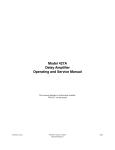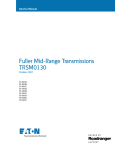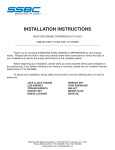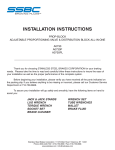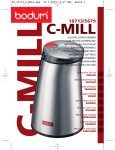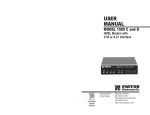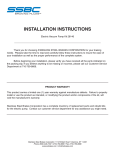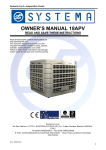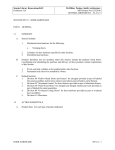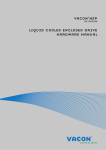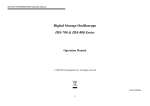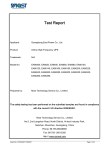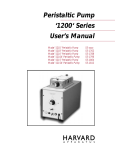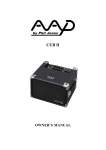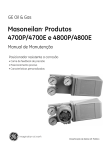Download GE Vector Data brochure
Transcript
® Vector VII Product Data Book GE Oil & Gas 5500 S.E. 59th Street Oklahoma City, OK 73135 Tel 405-670-1431 www.geoilandgas.com/artificiallift SAFETY NOTICE GE Oil & Gas places a high priority upon personnel safety. Personnel performing maintenance upon drives should be properly trained and follow all safety procedures to prevent injury. Drives may cause serious injury if proper safety precautions, equipment, and installation procedures are not used. Units should always be grounded and confirmation of ground connection and continuity be established prior to performing any work or service. Be sure to consult user’s manual before installing, energizing, or operating equipment. Installation should always conform to local codes, regulations, or other authorities governing electrical equipment. © GE Oil & Gas 2012 Revised November 2010 2 TABLE OF CONTENTS TOPIC © PAGE NUMBER Safety Notice 2 Introduction 5 Drive Description 5 Vector® VII Product Summary 6 Installation Examples 8 Catalog Number Explanation 9 Vector® VII without VSG® Catalog Numbers – 480 VAC 60 Hertz 10 Vector® VII with VSG® Catalog Numbers – 480 VAC 60 Hertz 11 Vector® VII without VSG® Catalog Numbers – 400 VAC 50 Hertz 12 Vector® VII with VSG® Catalog Numbers – 400 VAC 50 Hertz 13 Vector® VII Factory Installed Options 14 Manufacturer Qualifications and Certifications 17 General Specifications / Operating Conditions / Design Features 17 Operator Panel 22 Surface Pumping Systems (SPS™) 33 Input Harmonic Mitigation 34 Basic 12 Pulse and 18 Pulse Drive Schematics 35 Multi-Pulse Drives and Phase Shift Transformer Operation 36 Output Harmonic Mitigation 38 Grounding and Bonding / Typical 480 VAC Drive Installation 39 Generator Requirements 40 Custom Packages 42 Dimensions and Weights 44 Terms and Definitions 48 GE Oil & Gas 2012 Revised November 2010 3 © GE Oil & Gas 2012 Revised November 2010 4 INTRODUCTION This document provides a descriptive overview of the Vector® VII Variable Speed Drive (VSD) available from GE Oil & Gas. Information is provided on available ratings, physical size, product features, general operation, and available options. Additional details regarding drive set-up, operation, and troubleshooting are available in the Vector VII Variable Speed Drive User’s Manual. The descriptions and information contained in this publication are for informational purposes only and should not be used to install, set-up, program, or operate the Vector VII drive. Note: This publication describes the standard Vector VII Variable Speed Drive and includes descriptions of the most common drive options and modifications. Specific features may be added (or disabled) from the product depending on the specific application. All specifications and information contained in this publication are subject to change without notice. DRIVE DESCRIPTION The Vector VII Variable Speed Drive is designed specifically for oil-field pumping applications including electrical submersible pumps (ESP) and surface pumping systems (SPS). Vector VII drives are available in ratings from 104 KVA to1500 KVA. They are provided in rugged outdoor rated enclosures designed for a wide variety of environments ranging from arctic to desert conditions. Application specific software and a GE Oil & Gas Custom Operator Control Panel combine to optimize pump control while simplifying drive operation. Vector VII uses the latest Insulated Gate Bipolar Transistor (IGBT) technology in combination with surface mount printed circuit boards to create a VSD of the highest reliability, and small physical size. Fixed voltage, three-phase AC input power is first converted to a fixed DC bus voltage by the input rectifier section of the drive. That fixed DC bus voltage is then processed by the inverter section to produce a sine coded variable voltage, variable frequency output to control the speed of the motor. For ESP applications, the Vector VII Variable Speed Drive is available with integrated VSG® Technology. With VSG Technology the drive output voltage waveform is a near perfect sinewave which results in improved motor performance, extended motor run life, extended motor cable life, and increased operational efficiency in the driven equipment. Vector VII drives with VSG (Variable Sinewave Generation) technology can successfully operate with motor cable lengths up to 15,000 ft. User adjustments include operating speed, acceleration and deceleration rates, motor overload protection settings, auto restarts, time delays, and stopping methods. Control methods include frequency control, current control, pressure control, or analog follower (Analog 1 = 0-10 VDC, Analog 2 = 0-10 VDC or 4-20 mA) capability. © GE Oil & Gas 2012 Revised November 2010 5 VECTOR VII PRODUCT SUMMARY Standard Drive Features: • • • • • • • • • • • • • • • • • • Ratings from 104 KVA to 1500 KVA. Specifically designed for oil field pumping applications. NEMA 3R outdoor enclosure, rugged (10 Gauge) steel construction with compact footprint. Enclosure base pre-drilled with slotted holes for permanent attachment to foundation. Three point door latching mechanism. Designed for 50ºC (122º F) ambient temperature, white enclosure reduces solar heating. Input AC line circuit breaker with pad lockable flange mount external operator. State of the art operator control panel with graphical interface. Available with or without Variable Sinewave Generator (VSG) technology – pure sine wave output. Latest generation IGBTs (Insulated Gate Bipolar Transistors). Microprocessor based control circuitry with non-volatile memory for all drive parameters. Surface mount technology with protective coating on all printed circuit boards. Input line transient voltage suppression - line to line and line to ground voltage surge protection. Six pulse input rectification (standard) or optional multi-pulse rectification for reduced AC line harmonics. Fused control power transformer. Extended acceleration time - reduces electrical and mechanical stress on pump and motor. “S” curve soft start / soft stop capability. Power loss ride through capability. Operator Panel Features: • • • • • • • • • • • • • • • • • • • © Intuitive operator friendly menu is easy to use. Large bright screen is easy to read in direct sunlight. Built in real time clock – provides time and date stamp for historical data and event logger. Operator control panel monitors both drive parameters and well parameters. Note: GE Oil & Gas downhole sensor is required to monitor well parameters. Drive and well parameters are displayed in engineering units using plain language text. User programmable functions and operating modes. Set point PI control – closed loop – programmable in engineering units. Comprehensive run status screen shows critical drive and well data in a single location. Time stamped event and fault log - stores last 256 drive events including faults, starts, stops, operator changes, etc. Historical data log - periodically samples and stores the values of 20 different drive and well parameters. - All parameters are time (to the second) and date stamped with 35 days of data retained. Trending screen – graphically displays historical data for important drive and well parameters. Software embedded circular recording ammeter – high resolution display with 1 day or 7 day format. Drive Status Lights - Shows drive operating mode and are visible from a distance. Software embedded drive lock-out and auto-restart switches. Programmable restart capability. USB port for data retrieval and transfer of drive information to memory stick. - Save historical data, event log information, recording ammeter data, and drive configuration information. Built in Modbus communications port – easy interface to customer SCADA systems. Multiple Languages Password protection to prevent unauthorized changes. GE Oil & Gas 2012 Revised November 2010 6 Protective Features: • • • • • • • • • • • • • • • Input phase insensitive – sequencing of 3 phase input power is not necessary. DC bus reactor. Diagnostic fault indication. Loss of load detection. Serial communication loss detection. Short circuit protection. Ground fault protection. Loss of input phase protection. Over voltage and under voltage protection. Over current and under current protection. Current limiting DC bus fuse. Motor stall protection. Heat sink over temperature protection. Adjustable motor current limit. Critical frequency avoidance – three selectable frequencies with adjustable bandwidth. Electrical Specifications: Rated Input Voltage: Efficiency: Power Factor: Output Voltage: Output Frequency: 480 Volt, 3 phase, 60 Hz (+ / - 10% of rated voltage and frequency). Consult factory for other input voltages and frequency ratings. 97% or greater at full load. .95 or greater – Constant over operating range – Not speed or load dependent 0 Volts to rated input voltage 0 Hertz to 120 Hertz. Control Specifications: Control Method: Accel / Decel: Drive Overload: Current Limit: Sine coded output with optional VSG (Variable Sinewave Generation) technology. 0 Seconds to 6,000 seconds. 110% of drive rating for 60 seconds (Variable Torque). Programmable current limit. Control I/O: Digital Inputs: Digital Outputs: Analog Inputs: Analog Outputs: Analog Reference: Logic Reference: 7 Programmable inputs - 24 VDC, 8 mA – Sinking or Sourcing Logic. 2 Programmable dry contacts rated 250 VAC / 30 VDC @ 1A. 1 Fault contact - Form C dry contact rated 250 VAC / 30 VDC @ 1A. 2 Programmable inputs (10 bit). Analog 1 = 0 to +10 VDC – 20 K Ohms Analog 2 = 0 to +10 VDC – 20 K Ohms or 4 to 20 mA – 250 Ohms 2 Programmable outputs (10 bit) each = 0 to +10 VDC – 2 mA. +15 VDC Source – 20 mA. +24 VDC Source – 8 mA. Environmental Specifications: Ambient Service Temperature: Ambient Storage Temperature: Humidity: Altitude: Vibration: © GE Oil & Gas 2012 Revised November 2010 0°C to 50°C (32°F to 122°F) to -40°C (-40°F) with optional arctic package. -20°C to 60°C (-4°F to 140°F) 0 to 100% Up to 1000 Meters (3300 Feet) without de-rate. 9.81m/s2 (1 G) maximum at 10 to 20 Hz, 2.0 m/s2 (0.2 G) at 20 Hz to 50 Hz. 7 Various Installation Examples ESP Installation SPS Installation ESP Installation ESP Installation © GE Oil & Gas 2012 Revised November 2010 Offshore Installation 8 CATALOG NUMBER EXPLANATION D A B C E F G H to Z Drive Rated Rated Rated Enclosure Output Description Options Type Amps Volts Hertz Pulse Type Type Example V7 - 675A - 480V - 60HZ - 6P N3R - VSG AP Position Position A B © Description Vector 7 Drive Output Amps C D E Input Voltage Input Frequency Input Type F G H–Z Enclosure Type Output Type Options GE Oil & Gas 2012 Revised November 2010 Choices V7 125A, 180A, 240A, 304A, 414A, 515A, 675A, 910A, 1215A, 1366A, 1821A, Other 480VAC, 380VAC, 400VAC, Other 60HZ, 50HZ 6P = 6 Pulse, 12P = 12 Pulse, 18P = 18 Pulse, Other N3R = Nema 3R, N1 = Nema 1, Other VSG = Sine Wave, No Entry = PWM See Options Table on Page 14 9 VECTOR VII RATINGS AND CATALOG NUMBERS Vector VII Drives – without VSG (5) - 480 VAC / 60 Hertz (6) Catalog Number V7-125A-480V-60HZ-6P-N3R V7-125A-480V-60HZ-12P-N3R (3) V7-125A-480V-60HZ-18P-N3R (3) V7-180A-480V-60HZ-6P-N3R V7-180A-480V-60HZ-12P-N3R (3) V7-180A-480V-60HZ-18P-N3R (3) V7-240A-480V-60HZ-6P-N3R V7-240A-480V-60HZ-12P-N3R (4) V7-240A-480V-60HZ-18P-N3R (4) V7-304A-480V-60HZ-6P-N3R V7-304A-480V-60HZ-12P-N3R (3) V7-304A-480V-60HZ-18P-N3R (3) V7-414A-480V-60HZ-6P-N3R V7-414A-480V-60HZ-12P-N3R (3) V7-414A-480V-60HZ-18P-N3R (3) V7-515A-480V-60HZ-6P-N3R V7-515A-480V-60HZ-12P-N3R (3) V7-515A-480V-60HZ-18P-N3R (3) V7-675A-480V-60HZ-6P-N3R V7-675A-480V-60HZ-12P-N3R (3) V7-675A-480V-60HZ-18P-N3R (3) V7-910A-480V-60HZ-6P-N3R V7-910A-480V-60HZ-12P-N3R (3) V7-910A-480V-60HZ-18P-N3R (3) V7-1215A-480V-60HZ-6P-N3R V7-1215A-480V-60HZ-12P-N3R (3) V7-1215A-480V-60HZ-18P-N3R (3) V7-1366A-480V-60HZ-6P-N3R V7-1366A-480V-60HZ-12P-N3R (3) V7-1366A-480V-60HZ-18P-N3R (3) V7-1822A-480V-60HZ-6P-N3R V7-1822A-480V-60HZ-12P-N3R (3) V7-1822A-480V-60HZ-18P-N3R (3) Output KVA (4) 104 104 104 150 150 150 200 200 200 253 253 253 344 344 344 428 428 428 561 561 561 757 757 757 1010 1010 1010 1136 1136 1136 1515 1515 1515 Input Pulses 6 12 18 6 12 18 6 12 18 6 12 18 6 12 18 6 12 18 6 12 18 6 12 18 6 12 18 6 12 18 6 12 18 (1) (2) (3) (4) Output Voltage 480 480 480 480 480 480 480 480 480 480 480 480 480 480 480 480 480 480 480 480 480 480 480 480 480 480 480 480 480 480 480 480 480 Output Amperes 125 125 125 180 180 180 240 240 240 304 304 304 414 414 414 515 515 515 675 675 675 910 910 910 1215 1215 1215 1366 1366 1366 1822 1822 1822 Input Voltage 480 480 480 480 480 480 480 480 480 480 480 480 480 480 480 480 480 480 480 480 480 480 480 480 480 480 480 480 480 480 480 480 480 Input Amperes 125 125 (1) 125 (2) 180 180 (1) 180 (2) 240 240 (1) 240 (2) 304 304 (1) 304 (2) 414 414 (1) 414 (2) 515 515 (1) 515 (2) 675 675 (1) 675 (2) 910 910 (1) 910 (2) 1215 1215 (1) 1215 (2) 1366 1366 (1) 1366 (2) 1822 1822 (1) 1822 (2) Total input amperes. Amperes per input phase are 50% of listed value. Total input amperes. Amperes per input phase are 33% of listed value. Multi-pulse drives require a Phase Shift Transformer. This is not included with the drive. Output KVA calculated at 480 VAC. For input voltages other than 480 VAC Output KVA can be calculated as follows: Output KVA = Listed KVA x (Input Voltage / 480 VAC). (5) VSG or a separately mounted Sine wave output filter is required for ESP applications. (6) Consult Tables on Pages 12 and 13 for 50 hertz applications. © GE Oil & Gas 2012 Revised November 2010 10 VECTOR VII RATINGS AND CATALOG NUMBERS Vector VII Drives with VSG - 480 VAC / 60 Hertz (6) Output Catalog Number KVA (4) V7-125A-480V-60HZ-6P-N3R-VSG 104 V7-125A-480V-60HZ-12P-N3R-VSG (3) 104 V7-125A-480V-60HZ-18P-N3R-VSG (3) 104 V7-180A-480V-60HZ-6P-N3R-VSG 150 V7-180A-480V-60HZ-12P-N3R-VSG (3) 150 V7-180A-480V-60HZ-18P-N3R-VSG (3) 150 V7-240A-480V-60HZ-6P-N3R-VSG 200 V7-240A-480V-60HZ-12P-N3R-VSG (3) 200 V7-240A-480V-60HZ-18P-N3R-VSG (3) 200 V7-304A-480V-60HZ-6P-N3R-VSG 253 V7-304A-480V-60HZ-12P-N3R-VSG (3) 253 V7-304A-480V-60HZ-18P-N3R-VSG (3) 253 V7-414A-480V-60HZ-6P-N3R-VSG 344 V7-414A-480V-60HZ-12P-N3R-VSG (3) 344 V7-414A-480V-60HZ-18P-N3R-VSG (3) 344 V7-515A-480V-60HZ-6P-N3R-VSG 428 V7-515A-480V-60HZ-12P-N3R-VSG (3) 428 V7-515A-480V-60HZ-18P-N3R-VSG (3) 428 V7-675A-480V-60HZ-6P-N3R-VSG 561 V7-675A-480V-60HZ-12P-N3R-VSG (3) 561 V7-675A-480V-60HZ-18P-N3R-VSG (3) 561 V7-910A-480V-60HZ-6P-N3R-VSG 757 V7-910A-480V-60HZ-12P-N3R-VSG (3) 757 V7-910A-480V-60HZ-18P-N3R-VSG (3) 757 V7-1215A-480V-60HZ-6P-N3R-VSG 1010 V7-1215A-480V-60HZ-12P-N3R-VSG (3) 1010 V7-1215A-480V-60HZ-18P-N3R-VSG (3) 1010 V7-1366A-480V-60HZ-6P-N3R-VSG 1136 V7-1366A-480V-60HZ-12P-N3R-VSG (3) 1136 V7-1366A-480V-60HZ-18P-N3R-VSG (3) 1136 V7-1822A-480V-60HZ-6P-N3R-VSG 1515 V7-1822A-480V-60HZ-12P-N3R-VSG (3) 1515 V7-1822A-480V-60HZ-18P-N3R-VSG (3) 1515 Input Pulses 6 12 18 6 12 18 6 12 18 6 12 18 6 12 18 6 12 18 6 12 18 6 12 18 6 12 18 6 12 18 6 12 18 (1) (2) (3) (4) Output Voltage 480 480 480 480 480 480 480 480 480 480 480 480 480 480 480 480 480 480 480 480 480 480 480 480 480 480 480 480 480 480 480 480 480 Output Amperes 125 125 125 180 180 180 240 240 240 304 304 304 414 414 414 515 515 515 675 675 675 910 910 910 1215 1215 1215 1366 1366 1366 1822 1822 1822 Input Voltage 480 480 480 480 480 480 480 480 480 480 480 480 480 480 480 480 480 480 480 480 480 480 480 480 480 480 480 480 480 480 480 480 480 Input Amperes 125 125 (1) 125 (2) 180 180 (1) 180 (2) 240 240 (1) 240 (2) 304 304 (1) 304 (2) 414 414 (1) 414 (2) 515 515 (1) 515 (2) 675 675 (1) 675 (2) 910 910 (1) 910 (2) 1215 1215 (1) 1215 (2) 1366 1366 (1) 1366 (2) 1822 1822 (1) 1822 (2) Total input amperes. Amperes per input phase are 50% of listed value. Total input amperes. Amperes per input phase are 33% of listed value. Multi-pulse drives require a Phase Shift Transformer. This is not included with the drive. Output KVA calculated at 480 VAC. For input voltages other than 480 VAC Output KVA can be calculated as follows: Output KVA = Listed KVA x (Input Voltage / 480 VAC). (5) VSG or a separately mounted Sine wave output filter is required for ESP applications. (6) Consult Tables on Pages 12 and 13 for 50 hertz applications. © GE Oil & Gas 2012 Revised November 2010 11 VECTOR VII RATINGS AND CATALOG NUMBERS Vector VII Drives –without VSG (5) - 400 VAC / 50 Hertz (6) Catalog Number V7-125A-400V-50HZ-6P-N3R V7-125A-400V-50HZ-12P-N3R (3) V7-125A-400V-50HZ-18P-N3R (3) V7-180A-400V-50HZ-6P-N3R V7-180A-400V-50HZ-12P-N3R (3) V7-180A-400V-50HZ-18P-N3R (3) V7-240A-400V-50HZ-6P-N3R V7-240A-400V-50HZ-12P-N3R (3) V7-240A-400V-50HZ-18P-N3R (3) V7-304A-400V-50HZ-6P-N3R V7-304A-400V-50HZ-12P-N3R (3) V7-304A-400V-50HZ-18P-N3R (3) V7-414A-400V-50HZ-6P-N3R V7-414A-400V-50HZ-12P-N3R (3) V7-414A-400V-50HZ-18P-N3R (3) V7-515A-400V-50HZ-6P-N3R V7-515A-400V-50HZ-12P-N3R (3) V7-515A-400V-50HZ-18P-N3R (3) V7-675A-400V-50HZ-6P-N3R V7-675A-400V-50HZ-12P-N3R (3) V7-675A-400V-50HZ-18P-N3R (3) V7-819A-400V-50HZ-6P-N3R V7-819A-400V-50HZ-12P-N3R (3) V7-819A-400V-50HZ-18P-N3R (3) V7-1094A-400V-50HZ-6P-N3R V7-1094A-400V-50HZ-12P-N3R (3) V7-1094A-400V-50HZ-18P-N3R (3) V7-1229A-400V-50HZ-6P-N3R V7-1229A-400V-50HZ-12P-N3R (3) V7-1229A-400V-50HZ-18P-N3R (3) V7-1640A-400V-50HZ-6P-N3R V7-1640A-400V-50HZ-12P-N3R (3) V7-1640A-400V-50HZ-18P-N3R (3) Output KVA (4) 87 87 87 125 125 125 166 166 166 211 211 211 287 287 287 357 357 357 468 468 468 567 567 567 758 758 758 852 852 852 1136 1136 1136 Input Pulses 6 12 18 6 12 18 6 12 18 6 12 18 6 12 18 6 12 18 6 12 18 6 12 18 6 12 18 6 12 18 6 12 18 (1) (2) (3) (4) Output Voltage 400 400 400 400 400 400 400 400 400 400 400 400 400 400 400 400 400 400 400 400 400 400 400 400 400 400 400 400 400 400 400 400 400 Output Amperes 125 125 125 180 180 180 240 240 240 304 304 304 414 414 414 515 515 515 675 675 675 819 819 819 1094 1094 1094 1229 1229 1229 1640 1640 1640 Input Voltage 400 400 400 400 400 400 400 400 400 400 400 400 400 400 400 400 400 400 400 400 400 400 400 400 400 400 400 400 400 400 400 400 400 Input Amperes 125 125 (1) 125 (2) 180 180 (1) 180 (2) 240 240 (1) 240 (2) 304 304 (1) 304 (2) 414 414 (1) 414 (2) 515 515 (1) 515 (2) 675 675 (1) 675 (2) 819 819 (1) 819 (2) 1094 1094 (1) 1094 (2) 1229 1229 (1) 1229 (2) 1640 1640 (1) 1640 (2) Total input amperes. Amperes per input phase are 50% of listed value. Total input amperes. Amperes per input phase are 33% of listed value. Multi-pulse drives require a Phase Shift Transformer. This is not included with the drive. Output KVA calculated at 400 VAC. For input voltages other than 400 VAC Output KVA can be calculated as follows: Output KVA = Listed KVA x (Input Voltage / 400 VAC). (5) VSG or a separately mounted Sine wave output filter is required for ESP applications. (6) Consult Tables on Pages 10 and 11 for 60 hertz applications. © GE Oil & Gas 2012 Revised November 2010 12 VECTOR VII RATINGS AND CATALOG NUMBERS Vector VII Drives with VSG - 400 VAC / 50 Hertz(6) Catalog Number V7-125A-400V-50HZ-6P-N3R-VSG V7-125A-400V-50HZ-12P-N3R-VSG (3) V7-125A-400V-50HZ-18P-N3R-VSG (3) V7-180A-400V-50HZ-6P-N3R-VSG V7-180A-400V-50HZ-12P-N3R-VSG (3) V7-180A-400V-50HZ-18P-N3R-VSG (3) V7-240A-400V-50HZ-6P-N3R-VSG V7-240A-400V-50HZ-12P-N3R-VSG (3) V7-240A-400V-50HZ-18P-N3R-VSG (3) V7-304A-400V-50HZ-6P-N3R-VSG V7-304A-400V-50HZ-12P-N3R-VSG (3) V7-304A-400V-50HZ-18P-N3R-VSG (3) V7-414A-400V-50HZ-6P-N3R-VSG V7-414A-400V-50HZ-12P-N3R-VSG (3) V7-414A-400V-50HZ-18P-N3R-VSG (3) V7-515A-400V-50HZ-6P-N3R-VSG V7-515A-400V-50HZ-12P-N3R-VSG (3) V7-515A-400V-50HZ-18P-N3R-VSG (3) V7-675A-400V-50HZ-6P-N3R-VSG V7-675A-400V-50HZ-12P-N3R-VSG (3) V7-675A-400V-50HZ-18P-N3R-VSG (3) V7-819A-400V-50HZ-6P-N3R-VSG V7-819A-400V-50HZ-12P-N3R-VSG (3) V7-819A-400V-50HZ-18P-N3R-VSG (3) V7-1094A-400V-50HZ-6P-N3R-VSG V7-1094A-400V-50HZ-12P-N3R-VSG(3) V7-1094A-400V-50HZ-18P-N3R-VSG(3) V7-1229A-400V-50HZ-6P-N3R-VSG V7-1229A-400V-50HZ-12P-N3R-VSG (3) V7-1229A-400V-50HZ-18P-N3R-VSG (3) V7-1640A-400V-50HZ-6P-N3R-VSG V7-1640A-400V-50HZ-12P-N3R-VSG(3) V7-1640A-400V-50HZ-18P-N3R-VSG(3) Output Input Output KVA (4) Pulses Voltage 87 6 400 400 87 12 400 87 18 400 125 6 125 400 12 125 400 18 400 166 6 166 400 12 400 166 18 400 211 6 400 211 12 400 211 18 400 287 6 400 287 12 400 287 18 400 357 6 400 357 12 400 357 18 400 468 6 400 468 12 400 468 18 400 567 6 400 567 12 400 567 18 400 758 6 400 758 12 400 758 18 400 852 6 852 400 12 852 400 18 400 1136 6 400 1136 12 400 1136 18 (1) (2) (3) (4) Output Amperes 125 125 125 180 180 180 240 240 240 304 304 304 414 414 414 515 515 515 675 675 675 819 819 819 1094 1094 1094 1229 1229 1229 1640 1640 1640 Input Voltage 400 400 400 400 400 400 400 400 400 400 400 400 400 400 400 400 400 400 400 400 400 400 400 400 400 400 400 400 400 400 400 400 400 Input Amperes 125 125 (1) 125 (2) 180 180 (1) 180 (2) 240 240 (1) 240 (2) 304 304 (1) 304 (2) 414 414 (1) 414 (2) 515 515 (1) 515 (2) 675 675 (1) 675 (2) 819 819 (1) 819 (2) 1094 1094 (1) 1094 (2) 1229 1229 (1) 1229 (2) 1640 1640 (1) 1640 (2) Total input amperes. Amperes per input phase are 50% of listed value. Total input amperes. Amperes per input phase are 33% of listed value. Multi-pulse drives require a Phase Shift Transformer. This is not included with the drive. Output KVA calculated at 400 VAC. For input voltages other than 400 VAC Output KVA can be calculated as follows: Output KVA = Listed KVA x (Input Voltage / 400 VAC). (5) VSG or a separately mounted Sine wave output filter is required for ESP applications. (6) Consult Tables on Pages 10 and 11 for 60 hertz applications. © GE Oil & Gas 2012 Revised November 2010 13 OPTIONS TABLE Factory Installed options include: Code Name Ratings SH Space Heater All AP Arctic Package All DP Desert Package All Analog Output Converter Digital Input Converter All AOC DIC All TVSS Transient Voltage Surge Suppression All PJB Power Junction Box All TBX Terminal Block With Oversized Terminals All ES E-Stop All DSI DownHole Sensor Interface All Consult Factory for other options. © GE Oil & Gas 2012 Revised November 2010 14 Description Provides enclosure heating to prevent condensation from forming inside the drive enclosure. A Space Heater is generally not suitable for enclosure heating in cold climates. For enclosure heating in cold climates you should select the Arctic Package. Includes thermostatically controlled enclosure heaters and enclosure ventilation control to allow the drive to operate in cold climates at temperatures down to -40°C (-40°F). Enclosure mounted Sun Shield to reduce the amount of solar heating in high ambient temperature (desert) applications. Converts the two 0 to +/- 10V Analog Outputs on Vector VII to 4 to 20 ma outputs. Converts the seven 24 V DC Digital Inputs on Vector VII to 120 VAC Digital Inputs. The Vector VII drive includes surge protection suitable for most applications. This modification provides additional (very robust) protection against voltage transients and surges.. For added convenience and safety all drive power connections (3-phase drive input and motor output plus a ground connection) are wired to terminal blocks in a junction box mounted on the side of the drive enclosure. Digital and Analog inputs to the Vector VII are normally wired to a terminal strip on the drive chassis suitable for AWG #16 to #26 (.14 to 1.5 mm) stranded wire. This modification brings those connections to a conveniently mounted customer terminal block with oversized terminals. Provides door mounted emergency stop mushroom push button. Provides interface to the GE Oil & Gas SmartGuard® Downhole Sensor. Modification allows viewing of SmartGuard Sensor information on the drive Operator Control Panel. OPTIONS TABLE Factory Installed options include: Code Name BSP Back Spin Protection Ratings All CPT-500 Control Power Transformer 500 VA CPT-1000 Control Power Transformer – 1000 VA SPS PLC PLC for SPS Use All COMM1 Wireless Router Communications All COMM2 Ethernet Interface All All Consult Factory for other options. © GE Oil & Gas 2012 Revised November 2010 15 Description This modification is employed in ESP applications where fluid in the production tubing can cause reverse rotation of the pump and motor after the pump has been stopped. Backspin Protection prevents the automatic or manual re-start of the drive whenever the motor is rotating in the reverse direction. A Backspin Probe Assembly is included for connecting the high voltage motor leads located on the output side of the Step Up Transformer to the Backspin Protection Relay located inside the drive. Modification adds a Control Power Transformer to the drive. Secondary voltages of 120 VAC or 240 VAC are available. Two standard sizes are offered: 500 VA and 1000 VA. A GFCI Protected Convenience Outlet is also included. Select this modification when extra control power is required for customer use. Dedicated PLC is provided for automation and control of SPS Pump Applications. Functions include: Automatic Startup Sequencing, I/O Monitoring for System Protection and Control, Drive Speed Control via Programmable PID Loops. Hardware included: 8 Digital Inputs, 4 Digital Outputs, 8 Analog Inputs, 2 Analog Outputs, Modbus RTU Communications. Use your laptop computer as a Remote User Interface. This modification adds a wireless router to the drive which allows you to establish wireless communications with a nearby computer. Complete control and monitoring is possible. Access any Vector VII drive parameter. Provides remote user interface to drive via a wireless computer connection. Modification adds an Ethernet Interface (Modbus TCP communications) to the drive. Complete control and monitoring is possible. Access any Vector VII drive parameter via your Ethernet connection. Provides Interface from drive to Ethernet system. OPTIONS TABLE Factory Installed options include: Code Name Ratings COMM3 Cell Modem Interface All COMM4 Satellite Interface All Stainless Steel Construction All SST CE UL / CUL CE Certification UL Certification CUL Certification Only Available on Drives Rated 104 KVA to 561 KVA 104-561 KVA Non-VSG Drives Only Consult Factory for other options. © GE Oil & Gas 2012 Revised November 2010 16 Description Modification adds cellular communications to the drive. Complete control and monitoring is possible. Access any Vector VII drive parameter from a distant location. Hardware only - Connection Costs and Monitoring Fees are not included. Modification adds Satellite communications to the drive. Complete control and monitoring is possible via web access with password protection. Access any Vector VII drive parameter from a distant location. Hardware only - Connection Costs and Monitoring Fees are not included. Provides corrosion resistance in adverse operating conditions such as offshore platforms. Includes brass gland plate. When this option is selected the drive will be designed and manufactured in accordance with applicable European standards and a CE Declaration of Conformity will be provided. Complies with European Union Certification When this option is selected the drive will be built in accordance with the Underwriters Laboratory standard for Industrial Control Panels (UL508A). A UL508A label will be provided. These labels include both the UL and cUL marks for applications in the United States and Canada. MANUFACTURER QUALIFICATIONS GE Oil & Gas has been a supplier of drives for many years. Our drives are installed in a variety of oilfield pumping applications, both onshore and offshore. These include Electric Submersible Pumps (ESP), Surface Pumping Systems (SPS), and Progressing Cavity Pump (PCP) applications. GE Oil & Gas’s experience with a wide variety of different oilfield pumping applications has given us the unique ability to develop a specialized drive product for the markets we serve. Our drives include application specific software and a custom Operator Control Panel that provides a common, easy to use operator interface to both the drive’s parameters and the downhole or process sensors associated with the application. GE Oil & Gas can provide stand alone drives for indoor or outdoor environments or we can provide complete skid mounted packages including transformers that are easy to install and transport. We can also provide a total drive solution that includes switchgear, transformers, and a modular E-House complete with environmental controls and fire suppression systems. MANUFACTURER CERTIFICATIONS GE Oil & Gas is an ISO 9001 certified company. This ensures that all quality and corrective action procedures are documented and implemented to ensure the highest level of product quality. At GE Oil & Gas our goal is complete customer satisfaction. GENERAL SPECIFICATIONS / OPERATING CONDITIONS / DESIGN FEATURES Input Power Requirements: The GE Oil & Gas Vector VII drive is designed to accept three phase input power within a voltage range of 480 VAC, +/- 10%. Optionally the Vector VII drive can be configured to accept some other standard input voltage such as 380 VAC, +/- 10% or 400 VAC +/- 10%. The input frequency requirement of the Vector VII drive is either 50 Hz +/- 5% or 60 Hz +/- 5%. Consult factory for all voltage requirements other than 480 VAC / 60 Hz. The Vector VII drive has a 6 pulse input as standard and can also be supplied with an optional 12 pulse, or 18 pulse input rectifier for reduced Input AC line harmonics. These drive configurations will require a special input phase shifting transformer (consult factory for transformer requirements on all 12 pulse and 18 pulse applications). See harmonic mitigation section (page 30) for details on the benefits of multi-pulse drives. Electrical Noise Immunity: Noise immunity is in accordance with IEC61800-3. © GE Oil & Gas 2012 Revised November 2010 17 Output Power Characteristics: The Vector VII drive is designed to produce an adjustable voltage, adjustable frequency output to vary the speed of an AC induction motor. Output voltage is adjustable from 0 to 100% of the applied input voltage. Output frequency is adjustable from 0 hertz to 120 hertz. The inverter section produces a sine coded output waveform using proven IGBT technology. For applications requiring a sinewave output, optional Variable Sinewave Generator (VSG) technology is available. VSG technology minimizes the effects of reflected waves caused by long cable lengths. With VSG technology motors may be successfully operated using cable lengths up to 15,000 feet. Power Conditioning: An input isolation transformer is not required for protection from normal line transients. Overload Capability: Vector VII drives will produce 110% of rated output current for 1 minute. Efficiency: Vector VII drive efficiency is 97% or higher at full load and full speed. Enclosure Features: • • • • • • NEMA 3R outdoor rated. 10 gauge welded steel construction. Multi-stage paint process including iron phosphate wash for adhesion and white epoxy top coat. Lifting eyes. Lockable door handle and flange mount external circuit breaker disconnect handle. Door mounted Operator Control Panel - all drive adjustments can be made with the enclosure door closed. Hardware: The Vector VII employs the following power components: • • • • • • • • © Diode Input – 6 Pulse, 12 Pulse, and 18 Pulse configurations available. Inverter Section with the latest generation IGBT power devices DC bus inductor included on all ratings. Phase to phase and phase to ground MOV protection. Plug-in connections on printed circuit boards. Microprocessor based inverter logic isolated from power circuits. Operator Control Panel is common for all KVA ratings. Interface includes a large LCD graphical display with programming keys. Common control connections for all ratings. GE Oil & Gas 2012 Revised November 2010 18 Control Logic: The drive is programmable or self adjusting for operation under the following conditions: • • • • Operate drive with motor disconnected. Controlled shut down, with no component failure in the event of an output phase to phase or phase to ground short circuit and annunciation of the fault condition. Multiple programmable stop modes including - Ramp, Coast, Ramp-to-Hold, and S-curve. Multiple acceleration and deceleration rates. Terminal Blocks: Separate terminal blocks are provided for control and power wiring. Optional power junction boxes offer additional installation convenience. Control Inputs and Outputs: Digital Inputs: Digital Outputs: Analog Inputs: Analog Outputs: Analog Reference: Logic Reference: 7 programmable inputs - 24 VDC, 8 ma – sinking or sourcing logic 2 programmable dry contacts rated 250 VAC / 30 VDC @ 1A 1 fault contact - form C dry contact rated 250 VAC / 30 VDC @ 1A 2 programmable Inputs (10 bits) Analog 1 = 0 to +10 VDC – 20 K ohms Analog 2 = 0 to +10 VDC – 20 K ohms or 4 to 20 mA – 250 ohms 2 programmable outputs (10 bits) each = 0 to +10 VDC – 2 mA +15 VDC source – 20 mA +24 VDC source – 8 mA Customer Interface: Digital & Analog I/O © GE Oil & Gas 2012 Revised November 2010 19 Reference Signals: The Vector VII drive is usually configured to be controlled locally using the door mounted Operator Control Panel. Reference signals can also come from a remote controller when the Vector VII drive is connected to an external SCADA system. Vector VII can also be configured to follow other reference signals including analog input signals as listed below. 1. Remote potentiometer 2. 0-10 VDC 3. 4-20 ma Loss of Reference: The Vector VII drive can be configured to compensate for loss of its external frequency command. This command is considered lost if the drive reference drops to 10% of its value in 400 ms or less. Drive loss of reference can be programmed from 0 to 100% of drive’s speed command setting. Factory default setting is 80% of speed command. Power Loss Ride Through Capability: The Vector VII drive is capable of riding through a momentary loss of input power without shutting down. Automatic Restart: The Vector VII drive can be programmed to automatically restart after a drive fault. The number of restart attempts can be programmed from 0 to 10 with a factory default setting of zero. Time between restart attempts is programmable from .5 to 600 seconds with a factory de-fault setting of 180 seconds. Jump Frequencies: Three adjustable set points that lock out continuous operation at frequencies which may produce mechanical resonance are provided. Bandwidth is selectable from 0 to 20 hertz. Current Limit Programmable current limit is from 0% to 180% of drive rated output current. Acceleration / Deceleration Accel / Decel settings provide separate adjustments to allow either setting to be adjusted from 0.0 seconds to 6000.0 seconds. © GE Oil & Gas 2012 Revised November 2010 20 Minimum Frequency Limit / Fault The minimum frequency limit is set as a percentage of the command / set point frequency and may be used with PI control. If the drive senses this limit or drops below it a fault occurs and the drive will shut down. Bus Regulation DC Bus regulation is available to reduce the possibility of drive over-voltage trips due to regenerative conditions. Bus voltage is monitored and an internal regulator adjusts the drive’s output frequency to maintain bus voltage at a nominal (100%) level. Undervoltage trip occurs at 380 VDC and overvoltage trip occurs at 800 VDC. Underload Detection Enabled or disabled via programming, this feature allows the user to select the output current level that indicates the load has been lost. A programmable timing delay can also be set. Maximum time is 10 seconds. Motor Overload Protection Electronic motor overload protection is provided from both a current overload and motor overheating function. Exceeding either limit results in a trip / fault condition that will de-energize the drive. Trip time is user selectable. Motor overload (amps) parameter may be changed “on the fly”. Fault Memory / Event Log Faults can be accessed via the event log screen. The event log contains the most current 256 events with each being time stamped with the month, day, year, hour and minute of occurrence. Any parameter changes will contain previous and current settings for user reference. Data is stored in a non-volatile memory. Adjustments The Operator Control Panel is used for all set-up, operation and adjustment settings. All adjustments are stored in a nonvolatile memory. No potentiometer adjustments are used. Communications Interface Operator Control Panel has multiple user selectable communication port assignments for See Options list on page 12 for other communication protocols that can be used with the drive. Hard Start This function allows the operator to initiate a continuous forward / reverse start of downhole equipment. Function is designed for assistance in starting equipment that is difficult to start because of “sanded in” conditions or similar circumstances. Parameters are user configurable. © GE Oil & Gas 2012 Revised November 2010 21 OPERATOR CONTROL PANEL Interface to the Vector VII drive is provided via an Operator Control Panel with integral display. The display is easily read in bright sunlight and has a backlit LCD. It shows drive operating conditions, fault indications and programming information. The Operator Control Panel is standard on all drive ratings, has password protection, English and Spanish languages, and provides a monitoring interface to the optional SmartGuard® downhole sensor. Data can be retrieved from the drive using a laptop computer or memory stick via the USB port directly above the Operator Control Panel. Some of its features are as follows: • • • • • • • • • • • • Comprehensive Run Status Screen. (See Figure 1) Drive and well parameters are displayed in plain text. (See Figure 1) Operator Control Panel displays actual date and time. (See Figure 1 and Figure 2) Software Embedded Lock Out Switches. (See Figure 2) Intuitive Menu Select Screen. (See Figure 3) All Monitors Screen gives snapshot of drive and downhole sensor status. (See Figure 5) Software Embedded Recording Ammeter with 1 or 7 day format. (See Figure 6) Multiple Languages (See Figure 7) Time Stamped Event Log (256 events). (See Figure 16) SmartGuard downhole sensor screen. (See Figure 17) History Logs (35 days of data). (See Figure 18) Trending Screen for various surface and downhole parameters. (See Figure 19) A representation of the Operator Control Panel is shown below along with an explanation of the function keys. Operator Control Panel and USB Port © GE Oil & Gas 2012 Revised November 2010 Function Key Explanations 22 Operator Control Panel Drive Status Indicator Lights: The drive will display status information that can be seen from a distance showing the present operating state. Drive status indicators are as follows: • Green = Drive running. • Red = Drive stopped in ready state • Red and Amber = Drive stopped in fault state • Red with flashing Amber = Drive stopped in restart state. Drive will automatically restart – but the time to restart is greater than 1 minute. Flashing Light • Flashing Red and Amber = Drive stopped in restart or standby state. Drive will automatically restart in less than 1 minute. If in standby state, the drive will restart immediately whenever the standby switch closes. Both Lights Flash • Running in Alarm = Green with Flashing Amber. Flashing Light © GE Oil & Gas 2012 Revised November 2010 23 Operator Control Panel Screen Examples: Figure 1 Figure 2 Figure 3 Figure 4 Figure 5 © GE Oil & Gas 2012 Revised November 2010 Figure 6 24 Operator Control Panel Screen Examples: Setup Screen The Vector VII setup screen allows operational personnel to select a preferred language that is resident within the operator control panel. It also provides ability to set local date and time. Figure 7 Start up of the Vector VII drive can be easily accomplished using basic setup parameters such as minimum and maximum frequency, acceleration and deceleration times, motor data, overload and underload limits, and other parameters. An example screen is shown below. Frequency Setup Figure 8 © GE Oil & Gas 2012 Revised November 2010 25 Operator Control Panel Screen Examples: Alarms Setup The Alarms Setup screen allows a logged on user to set the overload and underload limits as well as other alarm parameters. See figures 12 and 13 below. Figure 9 Figure 10 Drive I/O Setup The user can easily determine the state of I/O settings at a glance by using this screen. S1 through S7 are user digital inputs, M1-M2 along with M3-M4 are digital outputs, A1 and A2 are analog inputs. Figure 11 © GE Oil & Gas 2012 Revised November 2010 26 Operator Control Panel Screen Examples: Communications (Comm) Setup A logged on user can define SCADA Modbus address and assign how the communication ports may be used. Comm port 2 is the default setting for external SCADA system communications. Figure 12 Miscellaneous Setup This screen allows a logged on user to configure various parameters. For example, enable or disable downhole sensor communications (SmartGuard), set output transformer winding ratio to allow calculation of downhole motor voltage and current, or external fault settings status selection. Figure 13 © GE Oil & Gas 2012 Revised November 2010 27 Operator Control Panel Screen Examples: Hard Start Screen User selectable for situations where pump may be “sanded in” and hard to start. This allows submersible equipment to oscillate at pre-determined intervals and ramp up to set point speed after equipment becomes free. Figure 14 Last Fault Screen User / operator can easily view current drive condition and when last fault occurred. Figure 15 © GE Oil & Gas 2012 Revised November 2010 28 Operator Control Panel Screen Examples: Figure 16 Figure 17 History Screen This screen displays logged performance data using 20 different parameters. They are as follows. Figure 18 Drive Outputs Volts Amps Hertz Analog 1 Analog 2 Digital Input © GE Oil & Gas 2012 Revised November 2010 DC Bus Volts Heat Sink Temp. KW PI Control Output Status SmartGuard Outputs Intake PSI Discharge PSI Intake Temp. Motor Temp. 29 Vibration Leakage Current UpHole DC Volts Transformer Outputs To Motor Volts Amps Operator Control Panel Screen Examples: Trending There are various user selectable parameters for trending. Among them are output current, output voltage, frequency, analog 1 or analog 2, intake pressure, intake temperature, and motor temperature. A SmartGuard V or VI downhole sensor must be used in conjunction with an optional drive downhole sensor interface board to obtain pressure and temperature data. The Vector VII drive will retain the most current 35 days of data and the user can select five days of this information for trending. The screen can provide a data magnification value of 16 so trend lines can be expanded to provide more detail of the results. Figure 19 Operating / Control Mode (Frequency and Analog Follower) Figure 20 Figure 21 The Vector VII drive is capable of operating as a frequency control, a current control, a pressure control, or it can be set to follow an Analog Signal from an external source. The above screens show how to configure the Vector VII drive for Frequency Control or Analog Signal Follower control. © GE Oil & Gas 2012 Revised November 2010 30 Operator Control Panel Screen Examples: Operating / Control Mode (Pressure) An example of the pressure control mode using the internal process PI regulator is shown in Figures 16 and 17. In this example if the pressure measured at the pump discharge falls below the set point, the drive will speed up and try to restore the pressure (up to the maximum frequency defined on the Frequency Setup screen – Figure 17). If the pressure exceeds the set point, the drive will slow to reduce the pressure (down to the minimum frequency defined on the Frequency Setup screen). The drive will adjust the frequency in the opposite direction if the intake pressure is used as a reference. Protection is provided for a loss of feedback or reference signal. Process control can be enabled or disabled with a hardwire input. Figure 22 Figure 23 Current Control Mode This allows the drive to operate with a constant current reference point and would primarily be used for gassy wells. Figure 24 © GE Oil & Gas 2012 Revised November 2010 31 Operator Control Panel Screen Examples: Maintenance Screen Logged on user can perform various functions such as checking or updating all drive parameters, resetting prior parameter settings to factory defaults, upgrading firmware, or downloading various logs and the internal digital recording ammeter data to a memory stick. Additionally, if several drives will have the same operating parameters these settings from the first drive can be downloaded to a memory stick and uploaded to the other drives via the USB port. This facilitates getting all drives running. Figure 25 Run Information Screen This screen provides basic information on data associated with drive run time, starts, and other information. Figure 26 © GE Oil & Gas 2012 Revised November 2010 32 Surface Pumping Systems (SPS™) Vector® VII drives are ideally suited for use with GE Oil & Gas Surface Pumps. An optional SPS System Controller is available to add the following functions often required in Surface Pumping applications: - Automated Pump Startup Control – The Pump Startup Sequence is automatically controlled based on a limited number of user inputs. - I/O Monitoring for System Protection and Control – Pump and System Sensors are monitored and may be configured to shutdown the system under abnormal operating conditions. - Drive Speed and System Control – After the Pump Startup Sequence is complete, the SPS System Controller will control drive speed based on one of several pre-defined control algorithms. - A second - PID Loop is also provided for control of auxiliary equipment such as valves. The SPS System Controller adds 10 Digital Inputs (120 VAC standard, 24 VDC optional), 6 Digital Outputs (Isolated Relay Contacts), 8 Analog Inputs (4 to 20 ma standard, 0 to 10 VDC optional), and 2 Analog Outputs (0 to 10 VDC or 4 to 20 ma). Modbus communications for interface to customer SCADA systems is standard. Control loop set points are user adjustable from the operator interface and feedback signals are derived from sensors mounted on the equipment. The following flow chart illustrates a typical SPS system start up sequence. Also shown is the SPS System Controller run screen and a typical SPS skid system. © GE Oil & Gas 2012 Revised November 2010 33 INPUT HARMONIC MITIGATION Excessive AC Line Harmonics can cause problems in the AC power system including the overheating of power system components such as transformers, circuit breakers, and panel boards. It can also cause nuisance tripping of circuit breakers, and the inadvertent transfer of electrical noise to critical loads such as communications systems, computers, and process control equipment. Drives are a potential source of AC line harmonics and control of those harmonics reflected back to the power distribution system may be an important consideration in the selection of a drive. Multi-pulse drives can help you maintain harmonics at an acceptable limit. Vector VII drives may be ordered with 6 Pulse (standard), 12 Pulse, and 18 Pulse input rectifier assemblies. The 6 pulse input rectifier assembly is generally accepted as the industry standard for low voltage AC drives. It is very simple, relatively inexpensive, and requires no additional (phase shifting) transformer for proper operation. When the control of Input AC line harmonics is important, 12 Pulse and 18 Pulse input rectifier assemblies are often selected. These drive configurations (12 Pulse and 18 Pulse) are sometimes referred to as “multi-pulse” drives. The input rectifier assembly for 12 pulse and 18 pulse drives is more complex than the input rectifier assembly for a 6 pulse drive – in fact, a 12 pulse input rectifier assembly consists of two 6 pulse rectifier bridges operating in parallel and an 18 pulse input rectifier assembly consists of three 6 pulse rectifier bridges operating in parallel. The added cost of these input rectifier assemblies is generally not that significant in the overall cost of the drive. The major cost differential (and it can be quite significant) between a 6 pulse drive and a 12 pulse or 18 pulse drive is the added cost of the Phase Shift Transformer that is required for “multi-pulse” operation. The multi-pulse phase shift transformers have conventional three phase inputs. The output of a 12 pulse phase shift transformer is a six wire connection and the output of an 18 pulse phase shift transformer is a nine wire connection. Twelve and Eighteen Pulse drives introduce lower levels of AC line harmonics into the power system than conventional Six Pulse Drives. Typical measurements for these various different front end configurations are shown below. These values should be used for estimating purposes only as measured results can vary based on line impedance, other linear loads on the feeder transformer, pre-existing harmonics due to other non-linear loads on the supply, and other factors. In general 12 pulse drives provide substantial reduction in power line harmonics over 6 pulse units and 18 pulse drives provide IEEE-519 compliance. © Category 6-Pulse Drive 12-Pulse Drive 18-Pulse Drive Current THD 30-35% 6.5-9.5% 4.5-5% Power Factor .92-.95 .97-.98 .98-.99 DPF .95-.97 .96-.98 .98-.99 K-Factor 3.0-5.0 2.0-3.0 1.0-2.0 GE Oil & Gas 2012 Revised November 2010 34 Multi-Pulse Examples: 12 Pulse Drive – Basic Schematic 18 Pulse Drive – Basic Schematic © GE Oil & Gas 2012 Revised November 2010 35 Multi-Pulse Drives and Phase Shift Transformer Operation The following is a brief and simplified overview of how phase shift transformers operate in conjunction with multi-pulse (12 or 18 pulse) drives. Keep in mind that multi-pulse drives are utilized to reduce the harmonics injected into the power source and they do not do anything to mitigate harmonics on the output (motor load) side. Six pulse drives do not require the use of a phase shift transformer. For this discussion the six pulse bridge is only used as a reference point to development an understanding of how multi-pulse bridges operate and their relationship to the phase shift transformer. A six pulse drive has one three phase power conversion bridge as shown below: In a six pulse drive, current flows into the drive in six approximately equal sized pulses during each A-C power cycle. For 60 Hz (60 Cycle) power there are 60 ac power cycles per second so what you have is 6 x 60 = 360 “nibbles” of current flowing into the drive every second. Harmonics are created because you are taking current out of the power system in “nibbles. In order to get lower harmonics you need to take more nibbles of current every second – think of the harmonics created in the power system like the vibrations created on the crank shaft when the cylinders fire in an internal combustion engine. If you have a 4 cylinder engine it produces greater vibration than a 6 cylinder engine. And a 6 cylinder engine has more vibration than an 8 cylinder engine and so on. Think of our 6 pulse bridge as a 6 cylinder engine. It would be nice (from a harmonic reduction standpoint) if we could replace our 6 pulse bridge (6 cylinder engine) with a 12 pulse bridge (12 cylinder engine) or an 18 pulse bridge (18 cylinder engine). A 12 pulse drive is built using two six pulse power conversion bridges as shown on the following page. © GE Oil & Gas 2012 Revised November 2010 36 An 18 pulse drive is built using three six pulse power conversion bridges as shown below. Somehow we need to create an electrical phase shift (offset) so that the two bridges in a 12 pulse drive are not firing at the exact same time or so that the three bridges in an 18 pulse drive are not firing at the exact same time. That is the function of the phase shift transformer. For a 12 pulse drive the input transformer takes a three phase input (3 input conductors) and it has two different three phase outputs (2 sets of 3 output conductors – 6 conductors total). The transformer is designed to create the required phase shift so that each bridge is firing exactly 180 degrees out of phase with the other (30º degrees phase shift). For an 18 pulse drive the input transformer takes a three phase input (3 input conductors) and it has three each three phase outputs (3 sets of 3 output conductors – 9 conductors total). The transformer is designed to create the required phase shift so that each bridge is firing exactly 120 degrees out of phase with the other (20º degrees phase shift). © GE Oil & Gas 2012 Revised November 2010 37 OUTPUT HARMONIC MITIGATION GE Oil & Gas developed VSG (Variable Sinewave Generator) technology specifically for Electric Submersible Equipment. It is a proprietary solution that provides a virtually pure sinewave output to downhole equipment and elimination of reflected wave phenomenon (motor spiking). Motor spiking can quickly destroy motor insulation and cause equipment failure. By virtue of VSG performance characteristics submersible motor heating caused by output harmonics is dramatically reduced. Typically the industry “rule of thumb” is that for every 10º C heat increase over the motor design point insulation life of the equipment decreases by 50%. Harmonics generate additional heat and mitigation of them can contribute to increased equipment life and in some cases lower operating expenses. VSG technology is effective with cable lengths up to 15,000 feet. Failed motor winding – Motor Spiking Vector VII with VSG – Virtually Pure Sinewave Output © GE Oil & Gas 2012 Revised November 2010 38 Grounding and Bonding Correct system grounding and equipment bonding is required to ensure proper operation of equipment during both normal operation and underfault conditions. Grounding and bonding conductors provide a path to ground for lethal fault currents and voltages. Failure to correctly ground and bond equipment can lead to equipment damage and personnel injury or death. Grounding applies to the main service connection to ground. Service transformer wye-point and enclosures, including the service disconnect switch, must be connected to a common ground conductor and grounding electrodes (Refer to local electrical authority for approved grounding electrodes and methods in your area). System ground resistance should not exceed 25 Ohms to ground and ideally be between 1-5 Ohms to ground. Ground resistance checks should only be made by qualified electrical inspection agencies. Bonding applies to all other electrical equipment and raceways. A bonding conductor must be connected from the main grounding electrodes to all enclosures, junction boxes, buildings, electrical pipes, and the wellhead. This equipment provides an internal ground connection for the bonding conductor. This connector is connected to the internal ground bus of the enclosure. A typical 3/60/480 VAC ESP installation is shown below. © GE Oil & Gas 2012 Revised November 2010 39 GENERATOR REQUIREMENTS Generators are often used as a source of power for oil field applications. When drives are operated from a generator, specific operational problems can occur unless the overall power system is properly designed for the application. Generators almost always have a higher source impedance than that of a typical electrical utility. Therefore, the non-linear current drawn by a drive tends to distort the generator output voltage waveform more than it would distort the voltage waveform of the electric utility. This distortion or “flat topping” of the generator output voltage waveform can confuse the generator’s voltage regulator and lead to a loss of voltage control and wide swings in generator output voltage. Because of this, the control of AC line harmonics is very important in generator applications. Whenever possible avoid situations where a generator is required to feed a load that consists mostly of non-linear loads (such as drives). It is best if the percentage of non-linear load can be kept to less than 20% of the total load connected to the generator. Often this is not possible. When a generator is used in a remote location as a power provider for a single drive or a group of drives, the percentage of non-linear load connected to the generator may approach 100%. In these situations, the following guidelines should be followed: 1. Use a multi-pulse drive (12 pulse or 18 pulse) to significantly reduce the AC line harmonics – this is usually your best approach. 2. Oversize the alternator component of the generator to lower the relative source impedance of the generator – doubling the size of the alternator will reduce the relative source impedance by 50%. While this may be helpful in applications where the percentage of non-linear load is less than 50% of the total connected load it will probably have little or no effect in applications where non-linear loads constitute a high percentage of the connected load. 3. Do not rely on the addition of AC line reactors between the generator and the drive to fix the problem – they simply add line impedance which often makes the problem worse. 4. Be very careful when applying harmonic filters to a generator system – passive harmonic filters generally consist of reactors and capacitors. The reactors add line impedance which usually does not solve your problem and the capacitors can cause the power factor to become leading under lightly loaded conditions. In general, generators do not like a leading power factor load – it confuses the generator’s voltage regulator and leads to a loss of voltage control and wide swings in generator output voltage. When Vector VII drives will be operated from a generator source it is best to contact GE Oil & Gas with the following information: 1. Generator information – Manufacturer, Model #, Output Voltage, Kw, KVA, and Impedance. 2. Load Information – This information should be in the form of a power one line diagram with complete information about all connected loads - linear and non-linear. It should also include information about any line reactors, transformers, harmonic filters, and power factor correction equipment included on the system. Generator supplied power systems have the same requirements for grounding and bonding as utility supplied systems. Grounding electrodes must be installed and a common bonding © GE Oil & Gas 2012 Revised November 2010 40 conductor must be connected to all equipment and buildings. When the generator system does not incorporate a wye-point for connection to the system ground, then an isolation transformer is required between the generator and input to the VSD. This provides protection from floating voltages, and provides a wye-point for connection to the ground system. Non compliance with the above guidelines will result in poor performance and / or equipment failure. A typical 3/60/480 VAC generator ESP installation is shown below. Vented Junction Box Detail See Application Brief 01010 and Drawing 146261 for additional references. © GE Oil & Gas 2012 Revised November 2010 41 Custom Packages: GE Oil & Gas’s Drives and Controls offers custom packages for special requirements. Among them are stainless steel enclosed drives for corrosive environments and offshore platforms, skid mounted drives, skid mounted drives with transformers / other auxiliary equipment, and electrical control rooms for onshore or offshore use. These electrical control rooms are sometimes referred to as E-Houses, power control rooms (PCRs), shelters, or cabins. These packages can also be offered in conjunction with SPS equipment or as an additional element to the system. Following are some examples. Vector VII Drive in Stainless Steel Vector VII Drives In E-House Vector VII Stainless Steel Drives on Offshore Platform © GE Oil & Gas 2012 Revised November 2010 42 Custom Packages: Skid Mounted Vector VII Drive with Transformers Skid Mounted Vector VII Drive with SCADA System and Transformers © GE Oil & Gas 2012 Revised November 2010 43 DIMENSIONS & WEIGHTS - VECTOR VII WITHOUT VSG REFERENCE ONLY “A” Frame FRAME A B © KVA @ 480 VAC 104 150 200 253 HEIGHT (INCHES / MM) H GE Oil & Gas 2012 Revised November 2010 “B” Frames WIDTH (INCHES / MM) W W1 DEPTH (INCHES / MM) D D1 80 / 2032 35 / 889 30 / 762 41 / 1042 36 / 915 82 / 2083 48 / 1220 36 / 915 42 / 1067 36 / 915 44 WEIGHT (POUNDS / KG) 750 / 340 944 / 429 1025 / 465 1100 / 499 DIMENSIONS & WEIGHTS - VECTOR VII WITHOUT VSG REFERENCE ONLY “C” Frame FRAME C D E © KVA @ 480 VAC 344 428 561 757 1010 1136 1514 HEIGHT (INCHES / MM) H GE Oil & Gas 2012 Revised November 2010 “D” and “E” Frames WIDTH (INCHES / MM) W W1 DEPTH (INCHES / MM) D D1 WEIGHT (POUNDS / KG) 88 / 2236 57 / 1448 48 / 1220 40 / 1016 36 / 915 1281 / 582 1325 / 601 1600 / 726 88 / 2236 99 / 2515 72 / 1829 53 / 1347 48 / 1220 4723 / 2143 88 / 2236 117 / 2972 90 / 2286 53 / 1347 48 / 1220 4800 / 2178 45 DIMENSIONS & WEIGHTS - VECTOR VII WITH VSG REFERENCE ONLY “A” Frame FRAME A B © KVA @ 480 VAC 104 150 200 253 HEIGHT (INCHES / MM) H GE Oil & Gas 2012 Revised November 2010 “B” Frames WIDTH (INCHES / MM) W W1 DEPTH (INCHES / MM) D D1 80 / 2032 35 / 889 30 / 762 41 / 1042 36 / 915 82 / 2083 48 / 1220 36 / 915 42 / 1067 36 / 915 46 WEIGHT (POUNDS / KG) 800 / 363 1320 / 599 1400 / 635 1470 / 667 DIMENSIONS & WEIGHTS - VECTOR VII WITH VSG REFERENCE ONLY “C” Frame FRAME C D E © KVA @ 480 VAC 344 428 561 757 1010 1136 1514 HEIGHT (INCHES / MM) H GE Oil & Gas 2012 Revised November 2010 “D” and “E” Frames WIDTH (INCHES / MM) DEPTH (INCHES / MM) D D1 WEIGHT (POUNDS / KG) W W1 103 / 2616 57 / 1448 48 / 1220 40 / 1016 36 / 915 1781 / 808 1825 / 828 2100 / 953 103 / 2616 99 / 2515 72 / 1829 53 / 1347 48 / 1220 5623 / 2551 103 / 2616 117 / 2972 90 / 2286 53 / 1347 48 / 1220 6000 / 2722 47 TERM DEFINITIONS TERM °C Degrees Celcius °F Degrees Farenheit AC Alternating current AI Analog Input AO Analog Output ASD COMM Adjustable speed drive Communications DC Direct current DI Digital Input DO Digital Output DPF Displacement power factor ESP Electric submersible pump HZ Hertz = Frequency in Cycles per Second I/O Inputs / Outputs IEC International electric code IEEE Institute of Electrical and Electronic Engineers IGBT Insulated gate bi-polar transistor ISO International Organization for Standardization KW KiloWatt = 1,000 Watts LCD Liquid crystal display mA milli Amp = 1/1,000 of an Amp MODBUS Serial Communication Protocol PI © DEFINITION GE Oil & Gas 2012 Revised November 2010 Proportional Integral 48 TERM DEFINITIONS TERM PCP Progressing cavity pump PLC Programmable Logic Controller PSI Pounds per Square Inch SCADA Supervisory Control and Data Acquisition SPS Surface pumping systems THD Total harmonic distortion TVSS Transient voltage surge suppression UL / cUL © DEFINITION Underwriters Laboratory for USA and Canada USB Universal Serial Bus VAC Volts AC VDC Volts DC VFD Variable frequency drive VSD Variable speed drive VSG® Variable Sinewave Generator GE Oil & Gas 2012 Revised November 2010 49 © GE Oil & Gas 2012 Revised November 2010 50 GE Oil & Gas Artificial Lift Headquarters GE Oil & Gas – Artificial List Operates in over 45 countries worldwide. One of the world's leaders in electric submersible pump service, manufacturing, innovative technology, and Performance Based Alliances. Manufacturing Centers in Oklahoma City, Midland, Casper, United Arab Emirates, Indonesia, Venezuela, Ecuador, Argentina, Canada and Russia. © GE Oil & Gas 2012 Revised November 2010 51 CORPORATE OFFICE & MANUFACTURING OUTSIDE U.S. SALES & SERVICE WORLDWIDE SALES & OPERATIONS CANADA 5500 S.E. 59th St (73135) P.O. Box 15070 (73155) Oklahoma City, OKlahoma, USA Tel 405-670-1431 Toll free 800-723-3771 Fax 405-670-5463 19416 Park Row, Suite 100 Houston, Texas 77084 USA Tel 281-492-5100 Fax 281-492-8107 U.S. SALES & SERVICE GULF COAST Brooks, Alberta Tel: 403-501-5822 Fax: 403-501-5823 Tunisia, Africa Tel: +216-7169-2281 Fax: +216-7169-2281 Calgary, Alberta Tel: 403-263-7166 Fax: 403-263-7211 Aberdeen, Scotland Tel: +44-1224-85-1000 Fax: +44-1224-85-1474 Leduc, Alberta * Tel: 780-955-2165 Toll free: 888-586-8909 Fax: 780-955-9487 LATIN AMERICA Houston, Texas Tel: 281-492-5100 Fax: 281-492-8107 Andrews, Texas Tel: 432-523-9701 Fax: 432-523-9700 Laurel, Mississippi Tel: 601-649-2030 Toll free: 800-488-9260 Fax: 601-649-8819 Midland, Texas * Tel: 432-699-7401 Toll free: 800-749-7402 Fax: 432-699-4159 ASIA / PACIFIC Tanggu, China Tel: +86-22-6691-4650 Chubut, Argentina * Tel: +54-297-446-8254 Fax: +54-297-446-8377 MID CONTINENT Snyder, Texas Tel: 325-573-9325 Fax: 325-573-1616 Jakarta, Indonesia Tel: +62-21-8370-2455 Fax: +62-21-831-2456 Bogota, Colombia Tel: +57-1-621-2425 Fax: +57-1-621-2264 ROCKY MOUNTAIN / PACIFIC Singapore Tel: +65-6396-3626 Fax: +65-6396-5362 Quito, Ecuador Tel: 593-2-2428-211 Fax: 593-2-2428-213 Bangkok, Thailand Tel: +66-2722-2389 Fax: +66-2722-0775 El Tigre, Venezuela Tel: +58-283-241-7151 Fax: +58-283-241-8613 RUSSIA / CIS Maracaibo, Venezuela * Tel: +58-261-200-9200 Fax: +58-261-7-361993 Oklahoma, City, Oklahoma* Tel: 405-671-1431 Toll free: 800-723-3771 Fax: 405-673-5463 Purcell, Oklahoma Tel: 405-527-1566 Toll free: 800-256-5058 Fax: 405-527-7161 PERMIAN BASIN Artesia, New Mexico Tel: 505-746-4614 Fax: 505-746-4519 Denver, Colorado Tel: 303-350-2111 Toll free: 800-535-0310 Fax: 303-350-2112 Baker, Montana Toll free: 800-535-0306 Fax: 307-234-4497 Moscow, Russia Tel: +7-495-937-6641 Fax: +7-495-937-6642 Casper, Wyoming * Tel: 307-234-4495 Toll free: 800-535-0306 Fax: 307-234-4497 Hobbs, New Mexico Tel: 505-392-7999 Fax: 505-392-8190 Al Shark, Kuwait Tel: 965-398-3639-2810 Fax: 965-398-3639-2811 EUROPE / AFRICA Shati Al Qurum, Oman Tel: 968-605501 Fax: 968-605784 Libya, North Africa Tel: +218-21-582-218-21-4842093 © GE Oil & Gas 2012 Revised November 2010 52 MIDDLE EAST Nizhnevartovsk, Russia * Tel: +7-3466-416-195 Fax: +7-3466-416-295 Chad, Africa Tel: +235-626-3279 Fax: +235-41723 *Manufacturing Facility in addition to Sales & Service. Buenos Aires, Argentina Tel: +54-4812-2329 Fax: +54-4812-2073 Dubai, UAE * Tel: +971-4-883-7595 Fax: +971-4-883-7579




















































